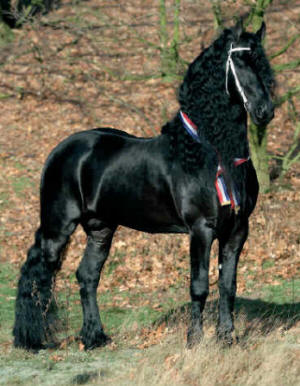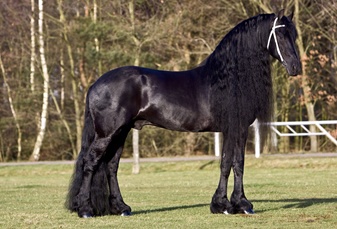In its appearance and bearing, the Friesian horse has remained practically the same down through the centuries, even though the various episodes in its history had sometimes placed quite different demands on the breed. These are exactly the characteristics that the Friesian; noblesse, spirit and pride as based on his own national character and his own history, would like to see in his favorite animal – as if this animal were a true reflection of his own personal history. Is it the majestically arched neck, the dark friendly eye, or is it the long black mane and the long wavy tail that give this animal its aristocratic bearing? In all probability, it’s not just one of these elements alone but the sum of the parts that evoke associations with the faraway past when loyalty and virtue were still chivalrous characteristics.
 Friesian horses are always black dressed up with the important characteristics of the breed; the luxuriance of the mane, forelock, tail and the fetlocks. The head must not be large or long, and the eye must be clear and friendly. The ears should not be excessively large but attentive, with the tips pointing just a bit toward the center of the poll. The head must be noble and expressive. The neck emerges at a point in the chest that’s not overly deep, displays sufficient length, and is not too heavy. The silhouette of the head and neck combined should present a beautiful crest giving the impression of the curve in a swan’s neck and head. The withers must be well developed and continue on sufficiently into the back. A height between 1.58 and 1.65 meters at the withers is a good height for a Friesian horse. The shoulder should be long and not steep. The back should be nicely muscled and – something that is seen fairly often – not too long either. The connection of the back through the loins to the croup is very important, since it has to be strong enough to transfer the energy generated by the hindquarters to the forehand. The croup must exhibit enough slope and length. The conformation of the legs is exceptionally important: they have to be correct in every regard as well as being hard and dry.
Friesian horses are always black dressed up with the important characteristics of the breed; the luxuriance of the mane, forelock, tail and the fetlocks. The head must not be large or long, and the eye must be clear and friendly. The ears should not be excessively large but attentive, with the tips pointing just a bit toward the center of the poll. The head must be noble and expressive. The neck emerges at a point in the chest that’s not overly deep, displays sufficient length, and is not too heavy. The silhouette of the head and neck combined should present a beautiful crest giving the impression of the curve in a swan’s neck and head. The withers must be well developed and continue on sufficiently into the back. A height between 1.58 and 1.65 meters at the withers is a good height for a Friesian horse. The shoulder should be long and not steep. The back should be nicely muscled and – something that is seen fairly often – not too long either. The connection of the back through the loins to the croup is very important, since it has to be strong enough to transfer the energy generated by the hindquarters to the forehand. The croup must exhibit enough slope and length. The conformation of the legs is exceptionally important: they have to be correct in every regard as well as being hard and dry.
 A great deal of attention has been devoted to the quality of the gaits in Friesian horse breeding. It is thus important that a Friesian horse possess a good walk, with good length of stride and sufficient flexibility. Its gaits are characterized by the elevated, reaching movement of the forelegs combined with a looseness in the shoulders and knee action, all of this made possible by sufficiently strong, sustaining hindquarters. The most important requirement for the trot is that it has to display sufficient reach. Due to a strict process of selection over the centuries, these are also the movement characteristics that are deeply embedded in the genetics of the Friesian breed. This also applies to the unique character of the Friesian horse: lively, intelligent, honest and reliable, always willing to work, but as proud as the Friesians themselves.
A great deal of attention has been devoted to the quality of the gaits in Friesian horse breeding. It is thus important that a Friesian horse possess a good walk, with good length of stride and sufficient flexibility. Its gaits are characterized by the elevated, reaching movement of the forelegs combined with a looseness in the shoulders and knee action, all of this made possible by sufficiently strong, sustaining hindquarters. The most important requirement for the trot is that it has to display sufficient reach. Due to a strict process of selection over the centuries, these are also the movement characteristics that are deeply embedded in the genetics of the Friesian breed. This also applies to the unique character of the Friesian horse: lively, intelligent, honest and reliable, always willing to work, but as proud as the Friesians themselves.


